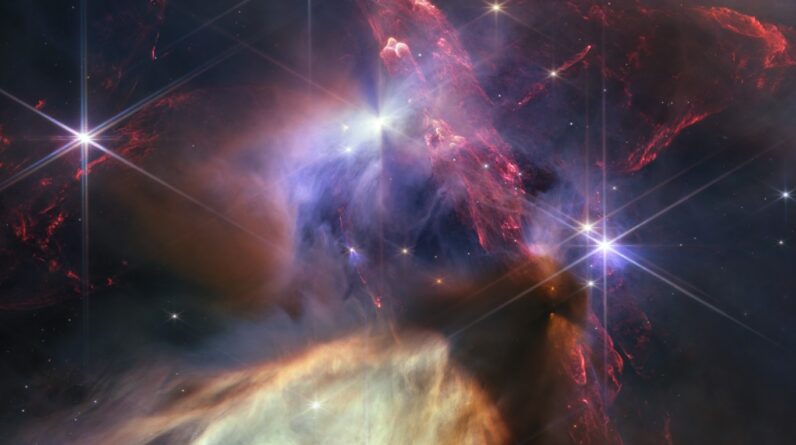
[ad_1]
The first anniversary image from NASA’s James Webb Space Telescope displays star birth like it’s never been seen before, full of detailed, impressionistic texture. The subject is the Rho Ophiuchi cloud complex, the closest star-forming region to Earth.
Credits: NASA, ESA, CSA, STScI, Klaus Pontoppidan (STScI)
For the last few decades, I’ve been watching just about every idea from the Golden Age of Science Fiction being recycled in science media. It’s been so fascinating to watch this superficial pseudo-thinking stagnation at work. The combination of ignorance, pomposity, and dogma makes a house brick look like a PhD thesis.
This tripe isn’t even reinventing the wheel. It’s pretending to have discovered the wheel and wondering what it’s for. It’s also why the “ideas market” is so pathetic these days. Most of what you read about anything to do with aliens is up to 100 years old, and it’s not getting any younger.
This is one of the most important questions to ever be asked by humanity. It needs an answer, not rehashed dogma. One of the oldest cliches in SF is carbon-based life forms.
At last, someone has come up with a basic statement of possible alien biochemistry, courtesy Space.com. It’s not a huge statement, but it’s enough to explain the core principles of life and self-replication.
It’s not full of itself, either. A process called autocatalytic reactions is what combines chemical elements into replicating forms. There are about 270 currently known different “cycles” of these reactions. So alien life definitely doesn’t have to stick to the terrestrial script.
Isaac Asimov, a biologist, did a novella called Mother Earth which examined alien biological issues in far more depth than ever since. Where’s the new thinking, O sainted prehistoric fools? Or is this just another shining example of non-cross-disciplinary ignorance?
Self-replicating materials are widespread enough on Earth. Why the gigantic holes in the logic about extraterrestrial autocatalysis? Self-replicating robots and organelles are among the more obvious.
Unlike the Fermi Paradox, in which you are mindlessly informed that something can’t exist because you haven’t seen it until you see it, this is a bit more practical. More importantly, it’s far more credible.
By the way – Paradoxes are paradoxes. Every paradox is its own answer. You have to understand the paradox to solve it. Not a lot of effort seems to be going in. Incidentally, how good is a theory that requires someone to come calling, and then refuses to admit that someone might have come calling for decades? This isn’t thinking, it’s blindfolding yourself and then telling people what you see. No physically blind person is that blind.
With a universe of unknown chemistry and compounds in any range of combinations, autocatalytic reactions make far more sense. You can’t deny the existence of the unknown.
You also can’t say that 270 different cycles will inevitably produce Mr. and Mrs. Commuter Earth 2023, simper a bit, and leave it at that. The universe is full of vast quantities of organic materials of all kinds. The more forensic forms of astronomy are finding whole spectrums full of them on a daily basis.
…All of which leads me to a question or two: Why is the modern thinking so backward and unproductive? When does a new generation of people start doing the thinking required about this? Answers are required. Squeaking about the Fermi Paradox answers nothing.
Autocatalysis has many obvious practical applications. Perhaps someone might condescend to alight from their discipline’s tin of baked beans and find out what.
Science is never currently wrong, according to current science. It’s only previously wrong, usually about almost everything, according to current science. That’s not good enough. …Because it can never be.
[ad_2]
Source link






